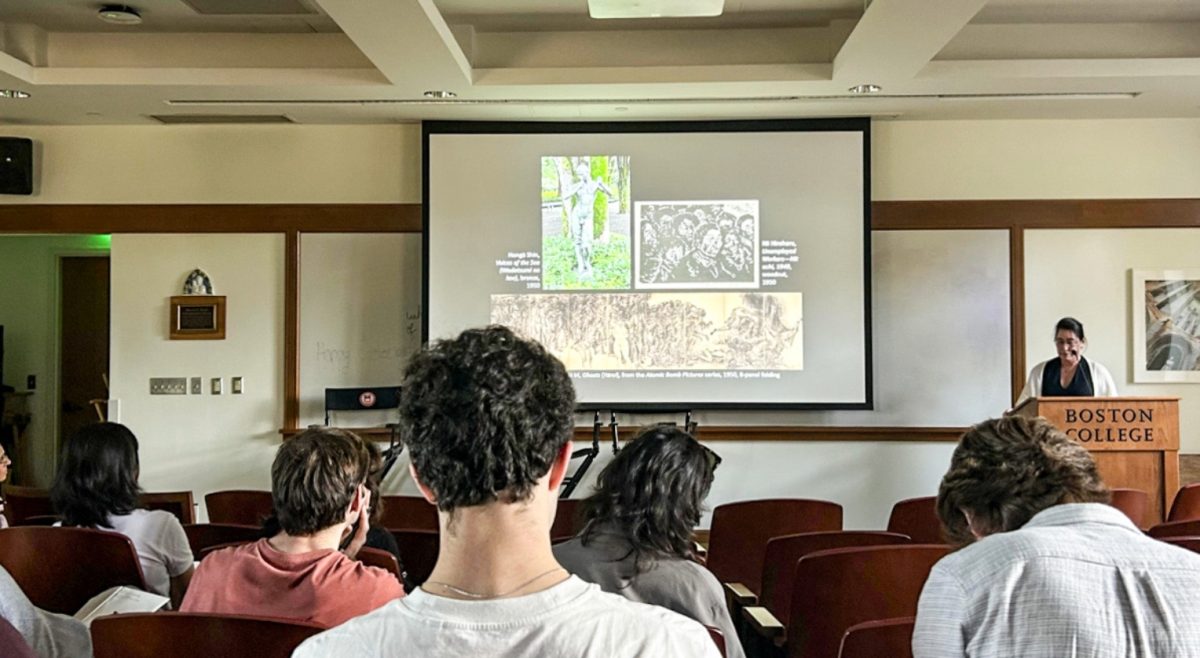Before the curtains open on Boston College theatre department’s latest production, prepare yourself for a whirlwind of entertainment and horror.
Dreadful engulfs its audience with repeated scenes of horror—slashed throats, women screaming, necks breaking. Prepare to encounter the occult, the paranormal, and the Gothic, all set against the backdrop of Jack the Ripper’s killing spree in Victorian England.
Luke Jorgensen, the chair of the BC theatre department, wrote and directed the new play Dreadful, running from Oct. 20 to 23 in Robsham Theater. In this one-act play, Jorgensen experiments with world-blending, bringing together well-known characters from beloved Gothic novels.
“I had an idea for this [play] last year,” Jorgensen said. “I wanted to do something a bit different—a suspense play.”
Gathering inspiration from classic novels like Frankenstein and Dracula, Jorgensen created a world in which these characters can interact with one another, yet the characters still get their own story lines and time on stage.
When the lights go down, the audience encounters this new, blended world. The horrifying elements pulled from different novels combine in the play, creating a heightened terrifying energy. Each well-known character’s frightening features multiply upon one another, intensifying the audience’s fear.

An unsettling melody fills the theater as the actors file onto the stage. Their footsteps echo as they take their places, creating a suspenseful atmosphere.
The striking set pieces include Brutalist-style buildings that fill the stage. Candles are scattered across the stage floor, adding to the eerie atmosphere. From the lighting booth, projections stream down onto the set, making the London street appear foggy. Red streaks of paint track down the buildings, reminiscent of blood—preparing the viewers for the gruesome show ahead.
The play opens with Dracula’s character Doctor Seward (Tyler Dean, MCAS ’25) discussing his scientific studies. In the background, Igor (Benjamin Burke, MCAS ’25) and a woman (Margaret Rankin, MCAS ’25) lie motionless on the stage, like dead bodies. They gradually become more animated before the woman is murdered and Doctor Seward yells, “Hell is upon us.”
In each scene, the suspense builds until, finally, there is a moment of catharsis from a jump-scare or a blood-curdling scream.
In one scene, a fortune teller named Madame Saskia (Megan Malcolm, MCAS ’24) performs a seance. The theater is filled with a warping sound that intensifies as Madame Saskia becomes possessed by one of the spirits.
She spins around to Lord Van Helsing (Ryan Kitz, MCAS ’23) and launches into a Scottish accent, scaring the wits out of Lord Van Helsing. Before the spirit is exorcized from her body, she lets out a deafening scream and dramatically falls to the ground.
At one point, Jonathan Harker (Daniel Strickland, MCAS ’25) alludes to the play’s historical setting. After hearing news of another murder, he ponders whether the recent disappearances are connected to Jack, referring to Jack the Ripper, an serial killer who was at large in England during the 19th century.

But among the terror-inducing frights, the play also has several moments of comic relief that lighten the mood. In one scene, Victoria Frankenstein (Emma Thompson, MCAS ’23) is performing an autopsy for Dr. Henry Jekyll (Cameron Mysliwicz, MCAS ’24). She is shamelessly flirting with Jekyll, who is completely oblivious to her attempts. She litters the conversation with innuendos, all unnoticed by Jekyll.
The play also considers the gender politics of the Victorian era. The simple fact that Victoria Frankenstein—a female version of the classic character,Victor Frankenstein—is performing an autopsy, which would be disallowed by Victorian standards, according to Jekyll, Illustrates a gender reversal.
In another scene, the setting changes to the Van Helsings’ dinner party. Twisted, gray curtains descend from the ceiling as Victorian aristocrats take to the stage, surrounded by butlers and waiting staff. The men and women stand separated in the grand room as the scene flip flops between the male conversations and the female conversations, emphasizing the gender divisions within the play.
One of the challenges during production, according to Jorgensen, was the play’s ballet scene. Jorgensen wanted all of the characters to watch a ballet while interacting with one another and commenting on the performance. But Jorgensen had no idea how to choreograph ballet, so he enlisted help from Amane Takaishi, a dance professor at BC, to choreograph the scene.
Near the conclusion of the play, the audience witnesses characters becoming increasingly dark. Even the light-footed ballerina (Margaret Hayes, MCAS ’25) switches from her baby-pink ensemble into a dark black and purple costume.
Other characters who originally seemed good begin to reveal their immoral qualities, becoming more dreadful and monstrous. The show leaves the viewer wondering: Who really is the monster?
Update 10/21/22 9:57 P.M.: The character’s name Igor was corrected to say Igor instead of Igor Dracula.













